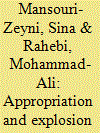| Srl | Item |
| 1 |
ID:
132102


|
|
|
|
|
| Publication |
2014.
|
| Summary/Abstract |
The two of us wrote Anti-Oedipus together. Since each of us was several, there was already quite a crowd.
-Deleuze and Guattari, A Thousand Plateaus
With the linguistic turn came an ever-increasing tendency to see language as the locus where truths are born, passed along, or modified. As such, postmodern theories have proved highly compatible with postcolonial studies, which have inspired studies of modern Iran as a country that was colonized, only not officially. However, the latter seem to have fallen for extreme abstraction where metaphysical claims abound: presuming constructivist views of language but failing to present a tangible framework, these studies discuss "discursive change" without giving a clue as to what either discourse or change is. Convinced as such, we have adopted Wittgenstein's idea of language-games to present a tangible model for discursive change.
|
|
|
|
|
|
|
|
|
|
|
|
|
|
|
|
| 2 |
ID:
128567


|
|
|
|
|
| Publication |
2013.
|
| Summary/Abstract |
As an acclaimed work of twentieth-century Persian fiction, Sadeq Hedayat's The Blind Owl has stirred much scholarly contemplation. Identical characters obscure the work; the resemblance amongst them seemingly originates in some mysterious old man. The paper first demonstrates how every male character resembles this old man. Thereafter, he is argued to be non-existent; all the characters, therefore, become Baudrillardian simulacra bound together through family resemblances. A language-game is then fashioned to represent the family. The metamorphosis of the narrator is followed to manifest how this language-game haunts the characters-other language-games. The paper hopefully sheds some light on an ambiguous aspect of the work and provides a model as to how one language-game takes over another.
|
|
|
|
|
|
|
|
|
|
|
|
|
|
|
|